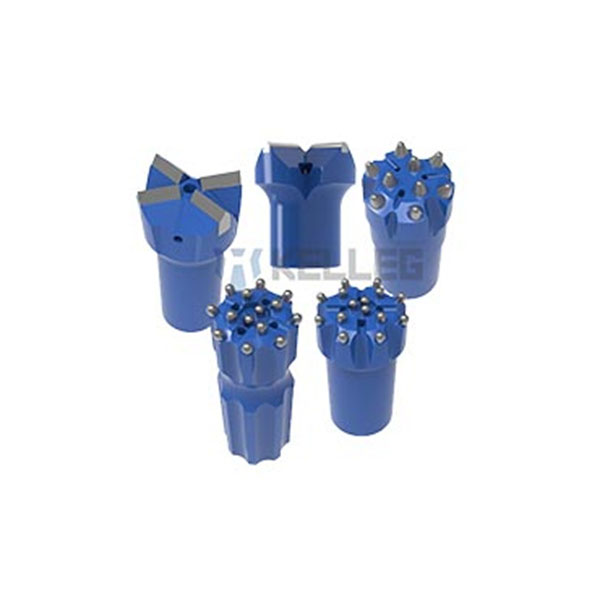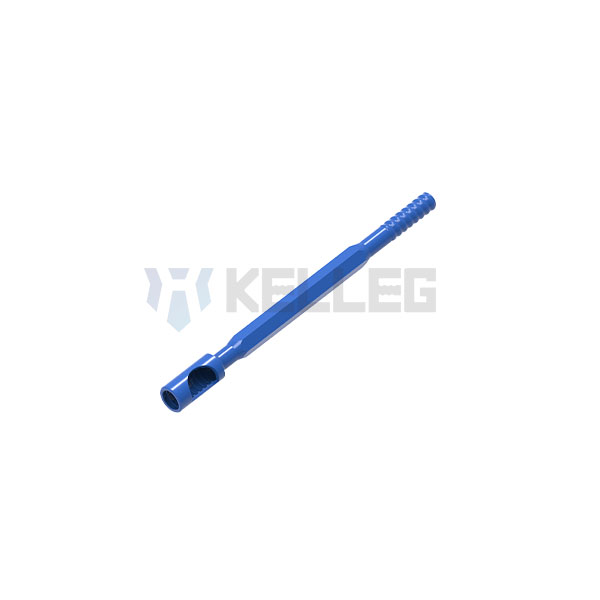2020 官网升级中!现在您访问官网的浏览器设备分辨率宽度低于1280px请使用高分辨率宽度访问。
Hydraulic rock drill jumbo is a machine that can support the rock drill to drill rock holes and walk with various powers. As an advanced rock drilling machine, it represents the development of rock drilling machines in drill and blast construction. Of course, the development of hydraulic rock drill jumbos has also promoted the development of its supporting rock drilling tools. There are a variety of rock drilling tools on the market. How to choose the right rock drilling tools for hydraulic rock drill jumbos is very important for users. We mainly share how to choose from the aspects of drill bits and drill rods.
1. Rock drill bits

To achieve the ideal rock drilling rate, it is required that the drill bit can effectively break the rock. Foreign users often use the index of rock drilling rate to evaluate the rock drilling speed of rock drill bit. Among the cross bits, X bits, and button bits, the rock-drilling rate index of ogive drill bit is the largest, followed by button bit and chip drill bit. Therefore, in the middle and deep hole drilling, the rock drilling speed of chip drill bit is the lowest, but in the comparison of drilling straightness, the drill bits that achieve the minimum deflection effect is X drill bit, followed by ogive drill bit, and button bit.
In addition, during the normal service life of button bit, it is necessary to avoid grinding the head of drill bit into a convex shape as much as possible. Because a worn drill bit not only reduces the chisel speed but also makes it easier to produce a skewed hole. During the rock drilling of button bit, the first thing is that gauge teeth are worn out, so the wear resistance of carbide button of button bit should be taken very seriously. At the same time, when drilling in medium to deep holes in low abrasive rocks, deep concave button bits are often used. When choosing a drill bit for drill jumbo, the type of drill bit should be determined according to the rock conditions.
2. Drill rods

According to the steel grade of hollow steel, the controlled cooling after rolling, and the surface hardness of the rod, three types of rods are mainly used in foreign hydraulic drill jumbos, which are surface-hardened rods, carburized rods, and carburized MF rods.
The toughness of surface-hardened rods is better than the overall carburized rods, but the fatigue life is lower, and these rods can be used for drilling interbedded rocks or fissured rocks. Carburized rods have good wear resistance and fatigue life, but their carburizing and air-cooling process requirements are very strict. When drilling holes with a depth of more than 20m, integral carburized rods and guided retract button bits can better control the deflection of holes and increase the service life of rock drilling tools.
In the drill rod connected by casing, the energy consumption generated at the connection is 6% when the T-thread is tightly connected and will exceed 10% if the threaded connection is poorly matched. High heat caused by energy consumption at the connection not only damages the thread but also tends to form a source of fatigue. Therefore, most foreign users choose long drill rods to reduce the connection points in the rock drilling tools when working on open-air projects.

MF rods were introduced by Kometa Finland in the late 80s for medium and deep holes, as the mass (weight) of these rods at the connection is less than 60% of casing connection rods. Therefore, the impact energy transfer is very effective. At the same time, because MF rod can maintain a tight connection throughout the rock drilling process, the energy application effect is also more significant than that of the casing-connected drill rod. This type of drill rod also has the advantage of easy automatic loading and unloading connection for rock drill jumbos, and it has become the main drill rod chosen for rock drill jumbos for open-pit medium and deep holes.
To sum up, the main basis for users to choose products is high-efficiency rock drilling speed, straighter hole straightness and ideal service life. To achieve these requirements, the drill rod should have high straightness, rigidity, toughness, good thread wear resistance and connection tightness. Drill bit should have suitable structure for different rock types, and be able to ensure minimum deflection in the drilling. When selecting rock drilling tools for open pit rock drill jumbos, most foreign users use MF rods to ensure the straightness of the blast holes because the depth of most blast holes is more than 15m. For blast holes with a hole depth greater than 20m, an MF guide rod with male and female threads is usually used in front of the first drill rod of rock drilling tools.